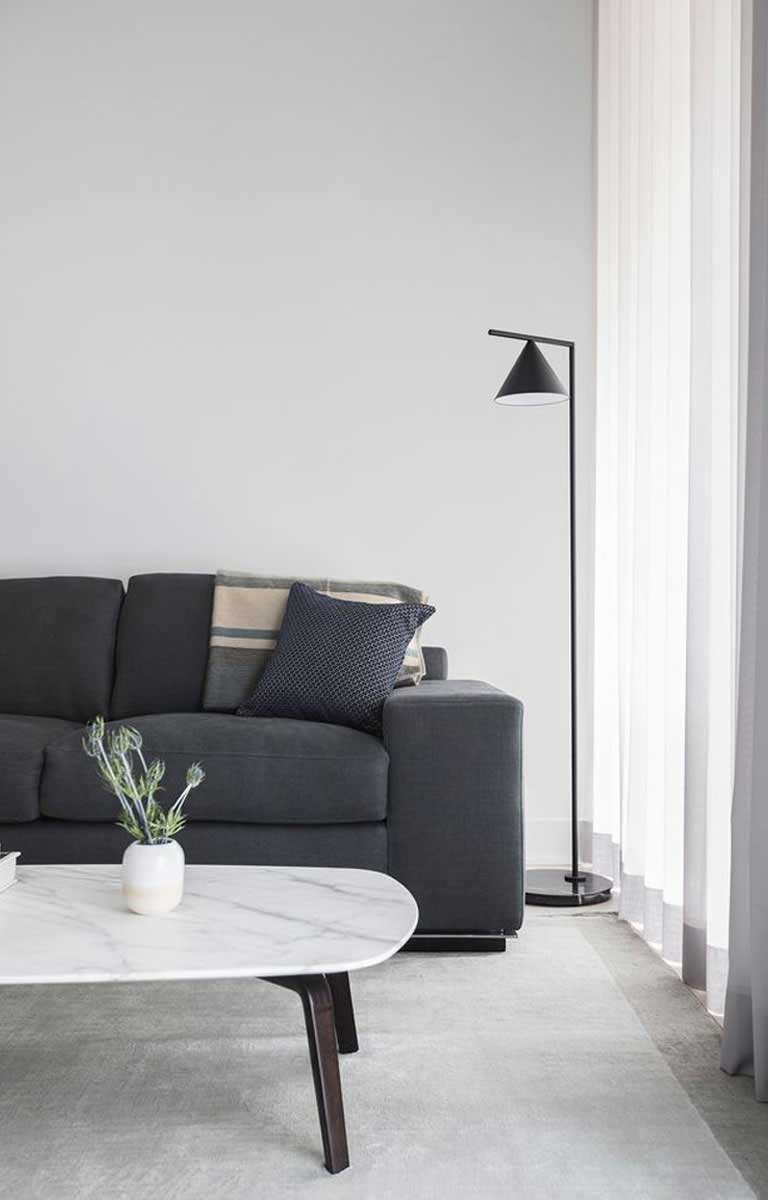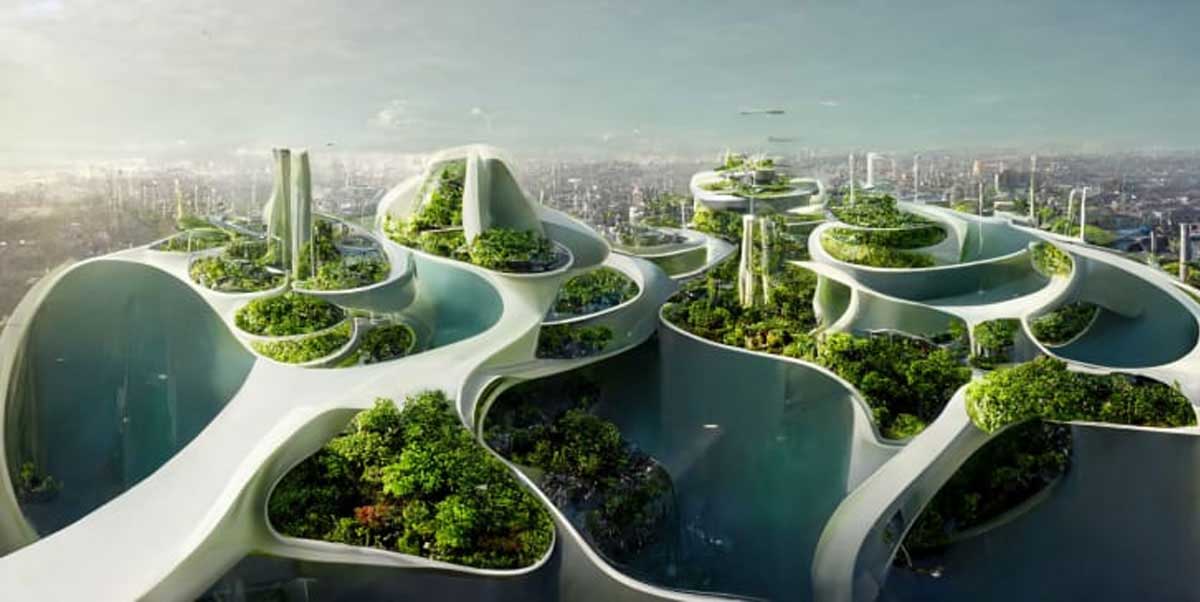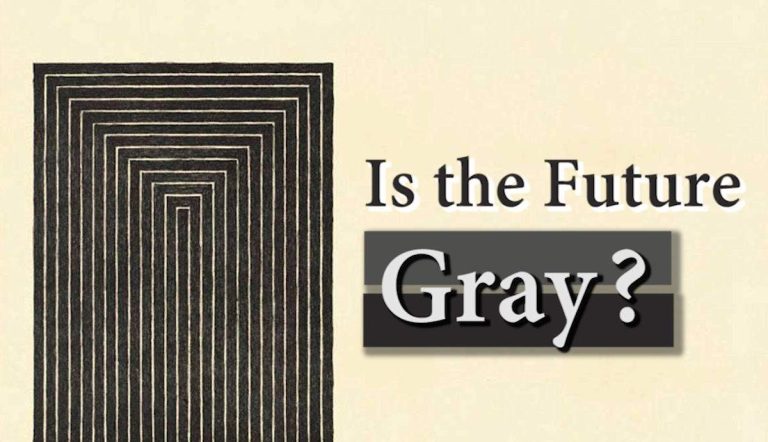
Dr. Kath Sleeman, a researcher at the Center for Policy Evidence, recently analyzed more than 7,000 photographs of everyday objects from the Science Museum Group's collection. Among all observations, an increase in gray tones and a decrease in warm tones stood out throughout the study. The gradual transformation of colorful objects into grayer and whiter tones can be understood from changes in material use and the era of industrialization. In postmodernism, this trend is observed in cultural tastes through the boom of minimalism in design. While not conclusive in any way, this study raises the question of whether design, art, science, and technology are pushing the world toward a homogeneous minimalist culture.
Gray in minimalism and abstract expressionism
 “Hey Ram” by Alfredo Jaar, 1991, via Artsy
“Hey Ram” by Alfredo Jaar, 1991, via Artsy
Minimalism is a design style that emphasizes simplicity and the use of a small number of colors, usually neutral or muted tones. Minimalists try to remove all unnecessary elements and leave only essential and functional components. The implementation is in the form of simple geometric shapes, monochromatic colors, lack of decoration and narrative content. Minimalism focuses on purity of form and the exploration of the relationship between an artwork and its surrounding space. Minimalist artwork is often characterized by its simplicity, precision, and industrial or machine-like appearance.
 “Autumn Rhythm” by Jackson Pollock, 1950, via Metropolitan Museum of Art, New York
“Autumn Rhythm” by Jackson Pollock, 1950, via Metropolitan Museum of Art, New York
In stark contrast, Abstract Expressionism, one of the most colorful art movements, emerged during the Cold War and had a strong influence on social and cultural liberalism. Abstract Expressionism moved away from realism and focused on emotional, personal, and expressive content centered on the artist as an individual. This took the form of abstract shapes and gestural brushstrokes intended to convey emotion and explore the artist's subconscious.
visualize the future
 Change in color of objects over time, Dr. Cath Sleeman, 2020, Science Museum, UK
Change in color of objects over time, Dr. Cath Sleeman, 2020, Science Museum, UK
Get the latest articles delivered to your inbox
Sign up for our free weekly newsletter
Please check your inbox to activate your subscription
thank you!
While minimalism emphasizes simplicity and reduction of form, abstract expressionism emphasizes spontaneity and the artist's emotional expression. Artists, designers, and sculptors have played an important role in helping minimalism and expressionism guide our choices and inform how we move into the future. Therefore, to understand the decline of color, we may need to uncover visions of the future painted by artists both past and present.
 Space Age by André Courrèges, 1993, via The Cut.Next to Thierry Mugler's “Spirare of the Future”, 1979, from W Magazine
Space Age by André Courrèges, 1993, via The Cut.Next to Thierry Mugler's “Spirare of the Future”, 1979, from W Magazine
Fashion is the basis of any cultural zeitgeist. During the Cold War, when Apollo 11 completed its mission to the moon, the West's cultural achievements were usurped by scientific fervor. Fashion designers such as Andre Courrèges, Paco Rabanne, and Thierry Mugler showcased their visions of a future of spacefaring humanity in their haute couture exhibitions.
For Courrèges, minimalism was important to distinguish scientific functionality from other aesthetics of the time. White was the dominant color, shapes were more symmetrical, and heavy embroidery was almost non-existent. Paco Her Rabanne approached this futuristic enthusiasm through an avant-garde lens, embellishing her models with paper, plastic, and metal. However, the most important correlation between futuristic visualization and minimalism can be seen in Thierry Mugler's cyborg vision. Despite his penchant for color, Mugler has remained close to his vision of the future, from a pleated silver dress that sparkles like tinfoil to a belted gold spacesuit with helmet-like headgear. Ta.
Designers have been imagining the colorful costumes of the future, but most retro and contemporary designers have envisioned the future from a minimalist perspective. A paradigm shift in fashion can only be noted in the growing preference for darker shades of gray instead of bright white. His Spring 2022 collections for Fendi, Schiaparelli, and Giambattista Valli unabashedly embrace this trend.
 Fendi SF Couture by Kim Jones, 2022, from Vogue.Next to Schiaparelli by Daniel Rosebery, 2022, from Vogue
Fendi SF Couture by Kim Jones, 2022, from Vogue.Next to Schiaparelli by Daniel Rosebery, 2022, from Vogue
In addition to fashion, minimalism has also influenced architecture and home decor. This trend continues to live on in several monumental buildings around the world. Observing futuristic design from Architectural Digest, almost all futuristic concepts are characterized by simple geometric shapes and limited use of color. The only color accents are found by incorporating plants and artificial lighting. Additionally, the project, which aims to create a realistic version of a sci-fi utopia, also includes a blueprint for minimalist rendering. Regarding current projects, a quick look at his NEOM, Saudi Arabia's planned smart city, reveals humanity's constant and unwavering path towards absolute minimalism.
 THE LINE, Neom, Saudi Arabia, via Neom
THE LINE, Neom, Saudi Arabia, via Neom
With all this progress in the outside world, the interior of the house has lost so much color. In interior design, futurism and minimalism go hand in hand. The future is often imagined in terms of artificial shapes featuring angular, curved glass, metal, and plastic designs. Despite being inspired by different cultures and eras, the furniture also leans towards minimalist principles. Electronics and lighting systems emphasize portability and functionality while occupying minimal space. This phenomenon will continue to build on minimalism.
 Minimalist Gray Interior Design, B Interior LLC, via ELLE Decor
Minimalist Gray Interior Design, B Interior LLC, via ELLE Decor
There is an argument that the most prominent and influential medium for the mass transfer of minimalism has come from cinema, especially science fiction. In movies, futuristic visions of the world are often rational, sophisticated, and minimalistic. Many of his science fiction films around the world depict a sophisticated, technologically oriented future where design is radically simplified and objects are reduced to their most essential elements. A notable example of this phenomenon can be seen in Stanley Kubrick's 2001: A Space Odyssey. The film features a minimalist design that emphasizes the smooth, clean lines of the white and gray technology used by the characters. The iconic Monolith is a perfect example of this minimalist design with its simple black rectangular shape.
 “The Barmecide Feast” by Simon Birch, 2018, National Air and Space Museum, Washington, DC
“The Barmecide Feast” by Simon Birch, 2018, National Air and Space Museum, Washington, DC
Mamoru Oshii's animated film Ghost in the Shell is another great example of how minimalism can be effectively used in storytelling and world-building. Negative space is used intentionally in this iconic anime. Many scenes in the film feature large, empty spaces to convey a sense of loneliness and isolation. Ghost in the Shell was also known for its distinct lack of color. The film primarily used shades of blue and gray, with occasional pops of red, yellow, and green. This limited color palette creates an atmosphere of isolation and anxiety, emphasizing the coldness and sterility of the future world. Its design elements, buildings, technology and vehicles were gray to emphasize efficiency and functionality.
The characters' clothing and hairstyles are also simple and efficient, conveying a sense of futuristic fashion. Movies have clearly contributed to the popularization of minimalism by presenting it as a desirable and attainable vision of the future. As a result, these films play an important role in encouraging people to adopt a minimalist lifestyle and design aesthetic.
The influence of gray on psychology and society
 Black Series I, Frank Stella, 1967, MOMA, New York
Black Series I, Frank Stella, 1967, MOMA, New York
Colors are known to have a huge impact on mood and emotions, and bright colors are often associated with happiness and joy. However, a research paper published in the International Journal of Applied Positive Psychology found that minimalism's impact on happiness had far more positive outcomes. Although this study did not focus on color reduction, it is noteworthy that color reduction largely disappeared with decoration reduction. Researchers cite a loss of creativity as another effect. Designers may struggle to create innovative designs with fewer colors and design elements.
This could make the world increasingly stagnant, leaving little room for creativity and experimentation. However, considering ecological and sustainable design efforts, most designers prefer to soften the impact of human technology while embracing the colors of nature as a utopian setting for future ecosystems. Masu. This trend, in which human activity coincides with part of the species' natural environment, can be traced back to posthumanist theory.
 AI x Future City, Manas Bhatia, 2022, via CNN
AI x Future City, Manas Bhatia, 2022, via CNN
On a global scale, researchers are concerned about several potential effects of reduced use of color. One of the most commonly cited negative effects is the loss of cultural diversity. Colors are often an important part of cultural identity, and different cultures give colors different meanings. As the use of color decreases, we risk losing cultural diversity and making the world increasingly homogeneous. The lack of color is colloquially called “chromophobia.” It is associated with social evils such as colonialism and racism, and the preference for colorful communities is considered inferior to European standards of color neutrality. Nevertheless, countries such as China, India, and Mexico, known for their vibrant cultural practices, are beginning to embrace minimalism while incorporating their own aesthetics into the principles.
 Paper mask by Dhanarakota Nageshwar and wooden bowl of Bhiksha Patra by Anantaya, from Architectural Digest
Paper mask by Dhanarakota Nageshwar and wooden bowl of Bhiksha Patra by Anantaya, from Architectural Digest
Similarly, Afro minimalism has redefined fashion trends across much of the African continent. Ghanaian designer Travis Obeng-Casper moves away from well-worn minimalist tropes of brushed metal, bright colors and Scandinavian pine forests, while centering the diversity, sustainability and cultural significance of African clothing. We are advocating a major departure. These processes include traditional design techniques and Africa's rich history. Although the reduction of color may seem to result in a dull, homogeneous world, these unique adaptations demonstrate further potential for innovation in this field.
Color minimalism: conclusion
Color minimalism has a positive impact on humanity by reducing visual clutter, increasing clarity, and improving accessibility. Additionally, environmental goals are also supported by reducing colorants and chemicals in manufacturing. However, it is important to note that colors have a positive impact on mood, emotions, and overall well-being. Some people find the absence of color dull or unstimulating, while others find the absence of color calming and peaceful. Furthermore, the cultural and personal associations with different colors differ in their impact on individuals. You might call it a trend or a trivial phenomenon, but going gray is a trajectory we've been following collectively, and perhaps unconsciously, for decades.

